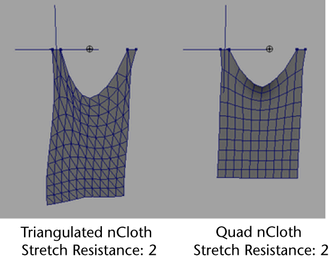This section provides guidelines that can help make your polygon geometry (input mesh) more suitable for conversion to an nCloth object.
Simulate nCloth using low resolution meshes
When modeling a mesh that you intend to convert to nCloth, be aware that the number of calculations required to simulate nCloth increase significantly as the resolution of the input mesh increases. This means that high resolution meshes take longer to simulate. If you are working with a high resolution mesh, one way of preserving the mesh’s detail and improve simulation time, is to create and then simulate a lower resolution proxy mesh. You can then use the simulated output mesh as a wrap deformer for your high resolution mesh. Use Mesh > Smooth on the output mesh to finish your nCloth effect. To avoid instances of mesh interpenetrations that may occur when using a wrap deformer, increase the nCloth object’s Thickness attribute to accommodate for the wrap deformer.
Model four-sided (quad) polygon meshes when possible
nCloth is, in part, composed of a network of cross links that prevent the cloth from shearing. Cross links are generated for quad polygon meshes, but not for triangulated polygon meshes. This means that nCloth created with triangulated polygon objects may not be as balanced as nCloth created from a quad polygons. For more information about nCloth links and cross links, see nCloth dynamics.
When triangulated mesh is used to create nCloth, biases in the areas and direction of the stretch resistance may occur during the simulation. In the nCloth example below, stretching biases appear in the triangulated nCloth in the area of the Transform constraint. In the quad nCloth mesh, the cross links allow for more uniform stretching.

The triangulated nCloth object may require higher Stretch Resistance, (especially triangles with edges aligned in the same direction) to keep the mesh uniform. Also, with biases, your nCloth simulation may not produce the desired effect. Input meshes created using Delaunay triangulation do not exhibit this bias.
The quad meshes used to create nCloth should have as uniform-sized quads or as close to uniform as possible. nCloth created from input meshes with similar sized polygons tend to produce more accurate collisions than nCloth meshes with varied size of polygons. nCloth output meshes made quad meshes can be easily smoothed downstream of the simulation, (using Mesh > Smooth) while triangulated meshes are harder to smooth without creating unwanted artifacts.